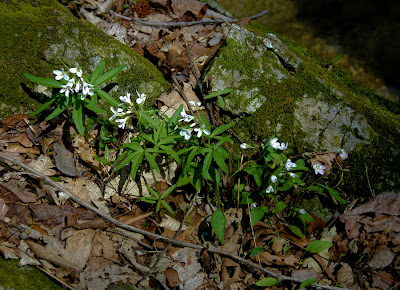 |
My vendor display includes a basket of
edible crops and a vase of wildflowers. |
My three-month-long manic book tour consisting of 32 events, including 5 two-days events, started this Saturday with the Annual Wildflower Festival in Deland, FL. I'm on tour to promote my new book "
Organic Methods for Vegetable Gardening in Florida." I think people are so ready for this book, that it will outsell my "Sustainable Gardening for Florida" within six months even though the sustainable book has done very well.
It's great to have both books to talk about at an event like this because they each cover different aspects of gardening. I sold a lot of the vegetable book and a few of the sustainable book to folks who were more interested in getting rid of their lawn or building rain gardens.
 |
My best show & tell item was the native wild
garlic. I gave out several of them to people who
bought my new book. |
It rained a little in the morning, which probably dampened the crowd somewhat, but most of the day was sunny and quite pleasant.
I love talking to people about gardening and of all the crops I brought, I found myself talking the most about the native wild garlic (
Allium canadense). People already know about curly and flat leafed parsley, Swiss chard, rosemary, white radishes, mint, and Greek oregano.
As the season progresses, the harvest I bring for show & tell will change, but I'll always bring something to demonstrate that I'm a real gardener with real dirt under my fingernails!
If you missed this first event, I hope to see you at one of my other events. See
my event calendar to find one near you. Note: the calendar does not include all 32 events because Master Gardener and some other meetings are not open to the public.
 |
| Deland is a beautiful historic town and is also the home to Stetson University. There was an art festival on the other side of town with a free shuttle between the two events. |
 |
| Elephant dill. |
Around the garden
I planted elephant dill for the first time this winter and was originally unhappy that more did not sprout. But then the one plant that did grow became huge--it was three-feet tall and almost as wide. Just one plant served us well through the winter months and until recently into the spring, but it had became too large for the stems and fell over.
There are a few other smaller plants around that we can use, so my husband and I are fine, but we'd seen some black swallowtail butterflies hovering around in recent weeks. Now those eggs will hatch on a dead plant, so I stuck the two stems in a bucket of water. I'll watch for those distinctive caterpillars and when they hatch I will transfer them to the dill & parsley row that I planted for these caterpillars.
The weather has been unusual with really chilly nights. It's great for the rest of the cool-weather crops so they'll get to harvestable size, but not so good for the new warm-weather crops, which would normally be planted now
I dug up the non-native string lilies (
Crinum x powellii) that were at the edge of the front meadow and have been replacing them with native bunching grasses, this provides more room for the beautyberry shrub, which has grown a lot in the last couple of years. Also, I wanted to provide a more native mix to edge the meadow. The grasses I'm using are Elliot's love grass (
Eragrostis elliottii), a bluish short, bunching grass, and muhly grass (
Muhlenbergia capillaris), a taller grass with pinkish flower heads in the fall.
I gave some of the string lilies to a neighbor and the rest I planted on the partly shady south side of the house in a bed with some daylilies. I still have some to plant, so I'll probably put the rest of them in the bed next to the screened porch.
I took a photo the other day of this native blue flag iris (
Iris virginica), which was the only flower in whole mass of leaves on the far side of our front pond. Maybe sometime this summer--after the book tour is over--I'll thin the irises to spread them around and to see if I can induce more blooming.
 |
This beautiful blue flag iris is blooming on our
pond out front. Isn't it gorgeous? |
 |
| String lily bulbs are enormous. |
I hope that your spring garden is growing well, and if you're in central or northern Florida, I look forward to meeting you at one of my events!
Green Gardening Matters, Ginny Stibolt 

.jpg)
.jpg)















.jpg)
.jpg)



